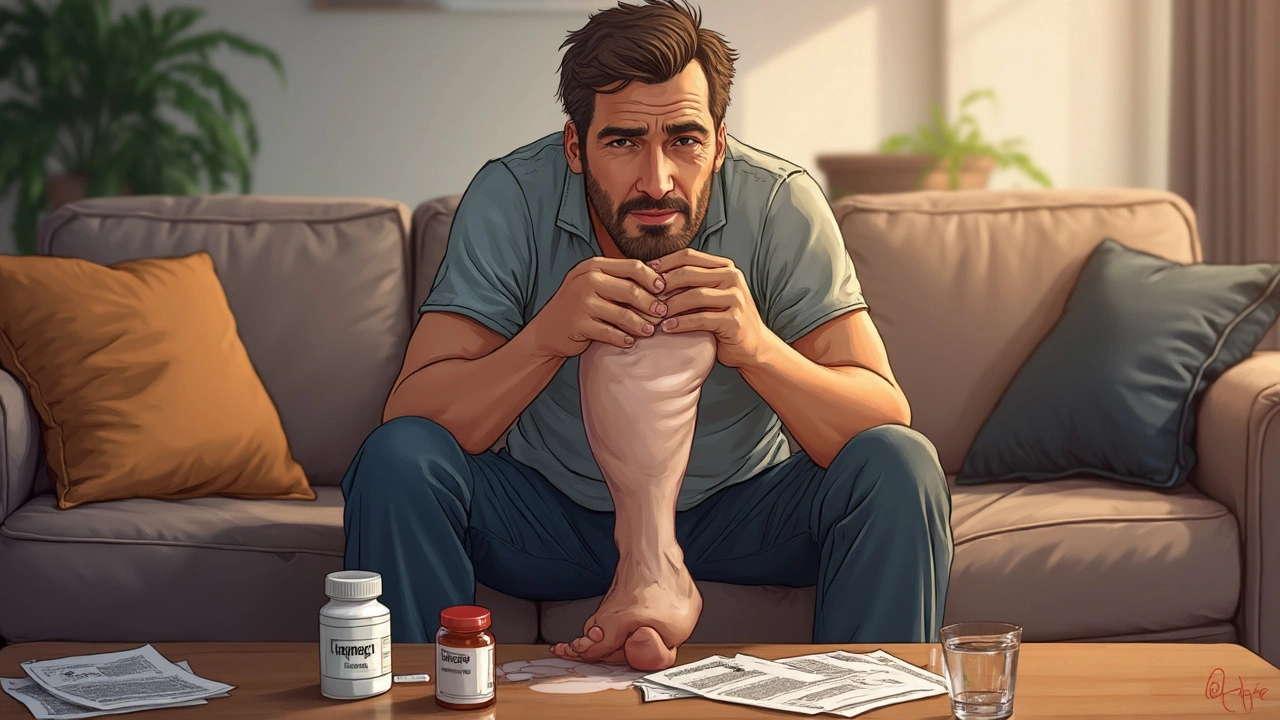
If you’ve ever had a gout flare, you know how brutal it is. It feels like someone drove a spike through your big toe, then twisted it for good measure. Gout flares don’t play nice. You want fast, safe relief—period. But with so many treatments on the table, which actually stacks up best for knocking gout back into submission?
How These Gout Medications Work
Let’s break down the three most popular contenders: prednisone for gout, colchicine, and NSAIDs. Each has its own quirky way of putting out the fire.
Prednisone is like a fire extinguisher. It’s a corticosteroid—meaning it dials down inflammation everywhere, not just where it hurts. This is great when the pain is wild and you need results fast. It’s often prescribed as a short ‘burst’—think five to ten days. The good: it works all over the body and is especially useful if NSAIDs and colchicine aren’t safe for you. The downside? Prednisone comes with a luggage cart of potential side effects even in the short run. Insomnia, jitteriness, increased blood sugar, mood swings, the whole cocktail. That’s why most docs use it as a backup, not the first string.
Colchicine is a little different. It doesn’t block pain or general inflammation, but it keeps white blood cells from piling into your joints and making things worse. The catch is that colchicine works best if you pop it right when symptoms start—wait too long, and it won’t do much. Nausea, diarrhea, and stomach cramps are incredibly common. If you’ve never run to the nearest bathroom after taking colchicine, consider yourself lucky. There’s also a limit to how much you can safely take in a day due to toxicity. Plus, it interacts with a ton of other medications.
NSAIDs—think ibuprofen, naproxen, or prescription indomethacin—are probably the first drug you’d reach for, especially if you’re younger and your kidneys and stomach are in good shape. These block the inflammatory enzyme COX and can cut the pain and swelling quickly. But NSAIDs can wreak havoc on your stomach lining, kidney function, and blood pressure if taken too long or in high doses. If you have heart risks or are over 65, doctors usually think twice.
Here’s a cheat sheet to wrap your head around how they stack up:
| Medication | Main Action | Time to Effect | Common Side Effects | Special Warnings |
|---|---|---|---|---|
| Prednisone | Suppresses inflammation everywhere | 12-24 hours | Password: Insomnia, mood swing, high blood sugar | Short-term only, caution in diabetes |
| Colchicine | Blocks cell migration to joints | Several hours | Stomach pain, nausea, diarrhea | Dangerous in overdose, many drug interactions |
| NSAIDs | Blocks inflammatory enzymes | Within 24 hours | Stomach ulcers, high blood pressure, kidney issues | Avoid in ulcers, heart/kidney/bleeding problems |
Does one work better than the rest? Several head-to-head studies actually found all three are very similar in taming acute gout attacks—if given quickly and at the right doses. The real game changer is your own medical baggage and how fast you can get the pill down.
Effectiveness: What Gets Gout Under Control Fast?
When your joint is on fire, your patience is zero. So which medicine actually cools things off the quickest? If you go by the largest gout trials in the last few years, the answer is: all of them, pretty much. For an average-sized guy having a flare, a 2017 multicenter study found that prednisone, colchicine, and NSAIDs took about the same amount of time—roughly 48-72 hours—for significant pain reduction.
One difference is the timing. Colchicine can sometimes work faster if you catch the attack in the first 12 hours. But if you wait, the benefit drops off. NSAIDs are for people who can swallow pills and haven’t trashed their stomach or kidneys yet. Prednisone tends to be the go-to if colchicine and NSAIDs are a no-go, or if your rheumatoid arthritis doc already has you on corticosteroids.
Another thing—most doctors combine colchicine or prednisone with ice packs and rest. Movement, especially early on, can make things worse.
There’s no huge difference in joint swelling resolution among the big three, but for disabling or more widespread gout attacks, steroids like prednisone can sometimes edge out the others, especially if taken by mouth.
Most importantly: these meds will not lower your uric acid or stop future attacks. They just treat the pain and swelling this time. You’ll need separate uric acid meds for actual long-term gout control. Still, for rapid-fire relief, any one of these can work, if taken pronto and at the right dose.
If you’re hunting for an alternative to Prednisone, look up natural anti-inflammatories or recent reviews to get fresh angles—but always double-check with your doctor first since not every option is safe for everyone.

Safety: Who Should Avoid Which Drug?
So, which of these drugs should you avoid like the plague? Here’s where it gets personal.
If you have a heavy history of peptic ulcers, high blood pressure, or kidney disease, NSAIDs are risky. Even short courses can push someone into serious trouble. Same goes for people on blood thinners or older folks over 65. That doesn’t mean NSAIDs are out for everyone—but for these groups, the downside can outweigh the flare relief.
Colchicine, on the other hand, is off-limits if you’re on certain cholesterol drugs (like statins), cyclosporine, or antibiotics such as clarithromycin. It can also cause dangerous muscle breakdown in older folks, or if you have severe kidney or liver disease. As little as twice the recommended dose can trigger toxicity, often showing up first as unstoppable diarrhea and then much worse. Don’t use it if you’re already running to the bathroom from a stomach bug—it’ll just make things grim.
Prednisone has the most wide-reaching side effects, even in short bursts. For anyone with diabetes, it can send your sugars to Pluto. It can cause mood swings that feel like you’re living with three different personalities, insomnia that laughs at melatonin, plus blood pressure spikes and fluid retention. People with infections, poorly controlled diabetes, or osteoporosis need close monitoring. On the other hand, it’s often the only safe choice in people who can’t take NSAIDs or colchicine—like those on blood thinners or with severe renal disease.
Allergies to any of these meds? You’re out of luck for that whole category. Always share your med list and health quirks with your doctor before picking a flare med. Twenty percent of patients have a reason not to take one of these by the time they turn sixty.
Tips for Making Gout Treatments Work Better
Even if you get the right med, there are hacks to make the pain go away even faster—or to stop the next flare from ever happening. Here’s what actual gout warriors have said helps:
- Take the first dose at the first sign of a twinge—don’t wait until your joint triples in size.
- Chill the area. Ice plus anti-inflammatory meds almost always works better than meds alone.
- Boost your water intake. Real talk: dehydration almost always comes before a flare. More water, less gout.
- Rest the joint. Don’t tough it out. Even walking around a little makes things worse in the first two days.
- If you’re on uric acid–lowering meds, never stop them during a flare. Stopping raises the risk of rebound flares.
- Avoid alcohol and high-fructose foods until the pain subsides—they make meds work less well and can trigger more uric acid spikes.
- Follow exact dose instructions for colchicine: more is NOT better. Accidental overdoses land people in the ER every year.
- Ask about stomach protectors (like omeprazole) if you must take NSAIDs but have stomach issues.
- Keep a printed copy or phone photo of your ‘flare action plan’ with doses and what to avoid.
One little-known fact: some patients with repeated flares end up with permanent joint changes, including lumps called tophi. Treat every flare like an emergency to lower your risk for long-term damage.

Combining Gout Treatments: What Really Works?
Tons of folks end up using combos—say, prednisone for a few days, then switching to NSAIDs once their stomach settles. Sometimes, doctors start colchicine and an NSAID together for one or two doses, but that raises the risk of side effects. The most common combo is a drug plus ice, elevation, and forced downtime. Rarely, a single steroid injection into the joint is used when oral meds can’t be taken—but this is more for knees than toes.
If your flares happen over and over, a doc may switch you to long-term uric acid lowering medications (like allopurinol or febuxostat) between attacks. These drugs slowly lower blood uric acid, which is great for stopping future attacks but does almost nothing for treating the current flare pain.
Another option, especially if you hate the side effects, is exploring every alternative to Prednisone that’s got real science behind it. Some people swear by cherry juice or high-dose vitamin C—but again, ask your medical team before making big changes. The science is still foggy about many of the natural ‘workarounds,’ but sometimes they’re worth a discussion, especially if you keep running into side effects from the big three meds.
Here’s where regular follow-up matters. The more your doctor knows about your triggers, patterns, and how you respond, the more likely you are to have a fast-acting, safe plan that’s waiting in your medicine cabinet for next time. Gout is one of those diseases where preparation really cuts down the suffering.
No one likes the idea of constant pills, but getting your uric acid under control (target is usually under 6 mg/dL for most adults) often means fewer flares and less reliance on heavy-duty drugs. If you’ve tried all three categories but still struggle, it’s time to bring up alternative therapies with your rheumatologist.
Write a comment
Your email address will not be published.






15 Comments
I totally get how miserable a gout flare can feel – it’s like a tiny firecracker set off inside your toe. The article does a solid job breaking down prednisone, colchicine, and NSAIDs, pointing out the speed‑of‑onset and side‑effect trade‑offs. It’s especially useful to see the quick‑look table that sums up action, time to effect, and warnings. For anyone juggling diabetes, kidney issues, or ulcer history, that checklist is a lifesaver.
Sure thing – prednisone works fast, but watch those sugar spikes, insomnia, and mood swings!
Reading through the mechanisms, I’m reminded that inflammation is a double‑edged sword ⚔️ – you want it out, but you don’t want the collateral damage. Colchicine’s precision is impressive, yet the gastrointestinal fallout can be brutal 😬. The take‑away is timing: catch that flare early, and the meds have a fighting chance. Keep hydrated and you’ll give them the best battlefield.
Man, I swear the med world is a conspiracy – they want us to suffer so they can sell more pills! Colchicine looks like a miracle but then it dropps you in the bathroom for days, like, “what the hell??” The side effects are sooo over the top, and they never tell you about the drug‑drug drama. And prednisone? Yeah, that’s just a shortcut to chaos, making you jitter like a busted alarm clock. Stay away unless you’re ready to sign a pact with the pharm‑industry.
The pharmacologic hierarchy delineated herein is ostensibly comprehensive yet suffers from a paucity of nuance. One must reckon with the ontological ramifications of systemic corticosteroids on metabolic homeostasis. Moreover the gastrointestinal peril inherent to NSAIDs remains an oft‑underestimated vector of morbidity. In sum the treat‑ise invites further scholastic interrogation
Hey fellow gout warriors, let’s dive deep into why the right drug can feel like a superhero cape on a bad day. First off, prednisone is a broad‑spectrum fire‑extinguisher that can calm the whole inflammatory storm in a matter of hours. It’s especially handy when you’ve got comorbidities that make NSAIDs a risky gamble. However, the sugar spike and sleepless nights are real villains that can sneak up on you if you’re not vigilant. Colchicine, on the other hand, is a precision strike that blocks the white‑blood‑cell march into the joint. When you pop it at the first twinge, it can shave minutes off the pain curve. But beware the gut‑turmoil-diarrhea can turn a simple flare into an all‑day marathon to the bathroom. Dosage matters; the modern low‑dose regimen is a game‑changer that keeps toxicity at bay. NSAIDs are the classic go‑to for many because they hit the COX enzymes fast and strong. If your kidneys and stomach are in good shape, ibuprofen or naproxen can bring relief within a day. Yet the lurking risks of ulceration and blood‑pressure spikes mean you should never ignore a protective proton‑pump inhibitor if you’re on them long‑term. A practical tip: combine any of these meds with ice packs, elevation, and a strict rest period for the first 48 hours. Hydration is your secret weapon-drinking plenty of water flushes uric acid and reduces recurrence. Finally, keep a written flare‑action plan in your wallet; knowing the exact doses and timing can prevent panic. Stay proactive, listen to your body, and partner with your doctor to fine‑tune the regimen that keeps you moving pain‑free.
Great summary, love how you highlighted the importance of early intervention 🌟. Remember to pair meds with lifestyle tweaks for optimal results 👍. Your proactive approach will definitely help many riders of the gout wave.
The blend of pharmacologic insight and practical advice reads like a well‑crafted symphony, each instrument-be it steroid, colchicine, or NSAID-playing its part in harmony. Your chart is a compass for the bewildered, steering them clear of perilous shores. Keep the melody flowing.
People need to stop treating meds like candy; you can’t just pop whatever looks shiny and hope for the best. Respect your body and the side‑effects, or you’ll pay the price later. It’s simple – responsible use wins.
Totally agree, taking it easy and listening to your body is key. A gentle reminder to stay hydrated and rest up when the flare hits. Simple steps make a big difference
The exposition provides a comprehensive overview of acute gout management, delineating the pharmacodynamics and risk profiles of each therapeutic class. It is commendable that the author emphasizes individualized treatment based on comorbid conditions. Such nuanced guidance is essential for optimizing patient outcomes while mitigating adverse events. The inclusion of lifestyle recommendations further enriches the discourse.
This article panders to Western pharma interests, ignoring indigenous remedies that have served our people for centuries. Stop kowtowing to multinational drug lobbies and demand homegrown solutions now.
Esteemed readers, the foregoing analysis elucidates the comparative efficacy and safety considerations inherent to prednisone, colchicine, and non‑steroidal anti‑inflammatory agents. It is incumbent upon clinicians to integrate this knowledge with patient‑specific factors to achieve optimal therapeutic outcomes. May this treatise inform judicious clinical practice.
Oh sure, because the next step is to create a “one‑size‑fits‑all” gout pill that solves everything, right? In reality, the best plan is a personalized cocktail, not a marketing gimmick. Keep the sarcasm alive while you tailor your regimen.
Exactly, why not add a dash of irony to the prescription while we’re at it? It’s the spice of life, after all.